The Art of War: Book Summary, Strategies, and Application in Business
VerifiedAdded on 2023/04/21
|6
|1625
|139
AI Summary
This document provides a summary of the book 'The Art of War' by Sun Tzu, exploring its strategies and their application in the business world. It discusses the importance of mastering the grounds beyond control, adapting to changes, and leveraging technology as weapons against competitors.
Contribute Materials
Your contribution can guide someone’s learning journey. Share your
documents today.
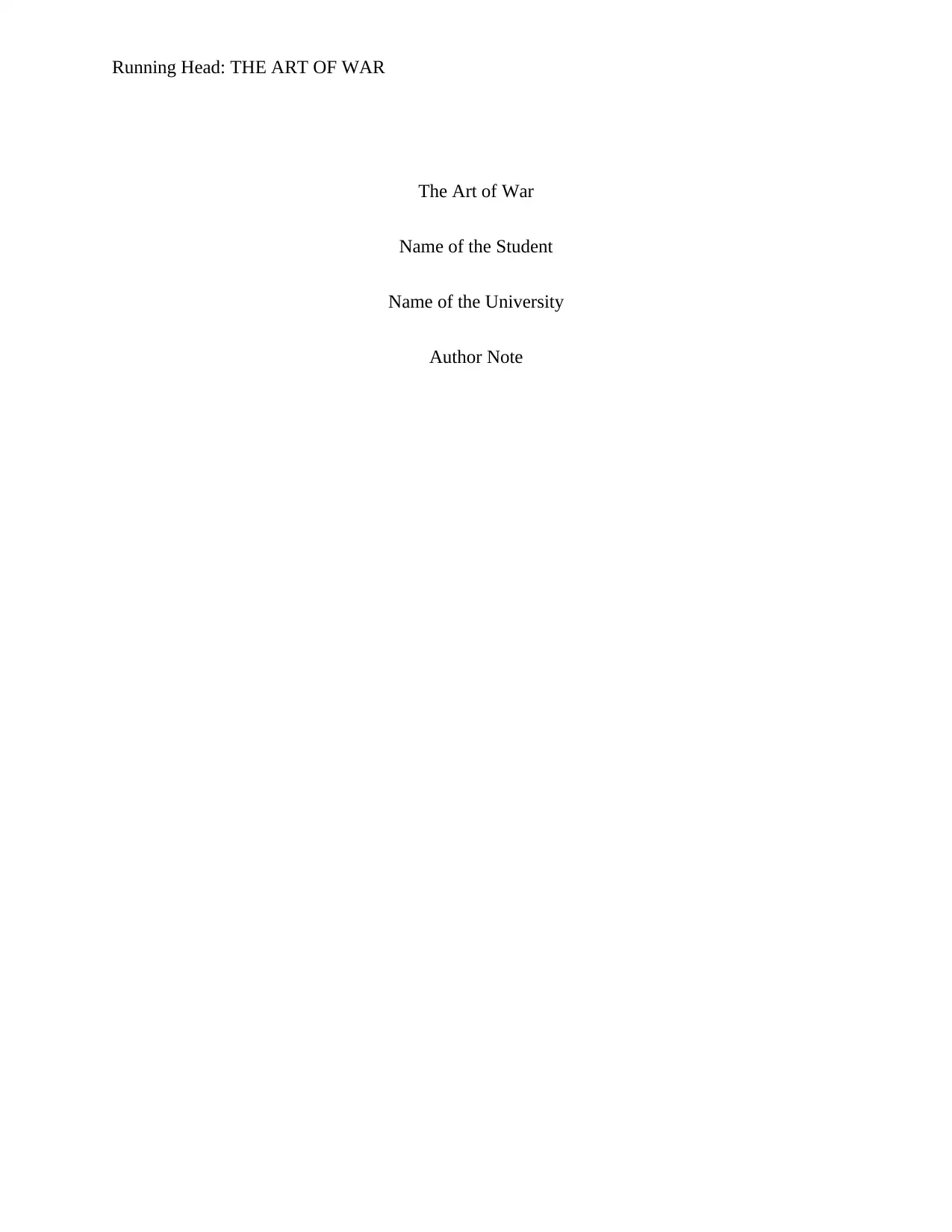
Running Head: THE ART OF WAR
The Art of War
Name of the Student
Name of the University
Author Note
The Art of War
Name of the Student
Name of the University
Author Note
Secure Best Marks with AI Grader
Need help grading? Try our AI Grader for instant feedback on your assignments.
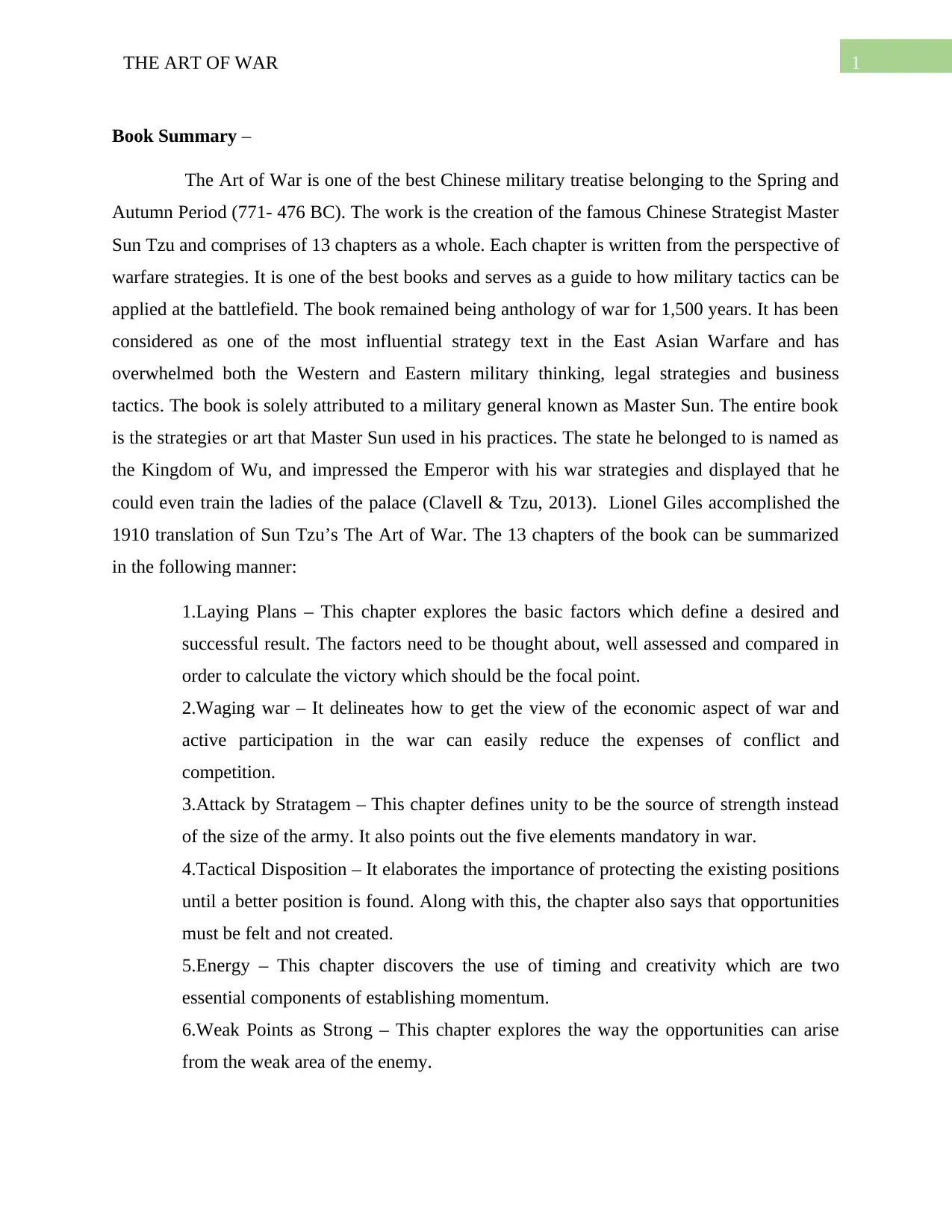
1THE ART OF WAR
Book Summary –
The Art of War is one of the best Chinese military treatise belonging to the Spring and
Autumn Period (771- 476 BC). The work is the creation of the famous Chinese Strategist Master
Sun Tzu and comprises of 13 chapters as a whole. Each chapter is written from the perspective of
warfare strategies. It is one of the best books and serves as a guide to how military tactics can be
applied at the battlefield. The book remained being anthology of war for 1,500 years. It has been
considered as one of the most influential strategy text in the East Asian Warfare and has
overwhelmed both the Western and Eastern military thinking, legal strategies and business
tactics. The book is solely attributed to a military general known as Master Sun. The entire book
is the strategies or art that Master Sun used in his practices. The state he belonged to is named as
the Kingdom of Wu, and impressed the Emperor with his war strategies and displayed that he
could even train the ladies of the palace (Clavell & Tzu, 2013). Lionel Giles accomplished the
1910 translation of Sun Tzu’s The Art of War. The 13 chapters of the book can be summarized
in the following manner:
1.Laying Plans – This chapter explores the basic factors which define a desired and
successful result. The factors need to be thought about, well assessed and compared in
order to calculate the victory which should be the focal point.
2.Waging war – It delineates how to get the view of the economic aspect of war and
active participation in the war can easily reduce the expenses of conflict and
competition.
3.Attack by Stratagem – This chapter defines unity to be the source of strength instead
of the size of the army. It also points out the five elements mandatory in war.
4.Tactical Disposition – It elaborates the importance of protecting the existing positions
until a better position is found. Along with this, the chapter also says that opportunities
must be felt and not created.
5.Energy – This chapter discovers the use of timing and creativity which are two
essential components of establishing momentum.
6.Weak Points as Strong – This chapter explores the way the opportunities can arise
from the weak area of the enemy.
Book Summary –
The Art of War is one of the best Chinese military treatise belonging to the Spring and
Autumn Period (771- 476 BC). The work is the creation of the famous Chinese Strategist Master
Sun Tzu and comprises of 13 chapters as a whole. Each chapter is written from the perspective of
warfare strategies. It is one of the best books and serves as a guide to how military tactics can be
applied at the battlefield. The book remained being anthology of war for 1,500 years. It has been
considered as one of the most influential strategy text in the East Asian Warfare and has
overwhelmed both the Western and Eastern military thinking, legal strategies and business
tactics. The book is solely attributed to a military general known as Master Sun. The entire book
is the strategies or art that Master Sun used in his practices. The state he belonged to is named as
the Kingdom of Wu, and impressed the Emperor with his war strategies and displayed that he
could even train the ladies of the palace (Clavell & Tzu, 2013). Lionel Giles accomplished the
1910 translation of Sun Tzu’s The Art of War. The 13 chapters of the book can be summarized
in the following manner:
1.Laying Plans – This chapter explores the basic factors which define a desired and
successful result. The factors need to be thought about, well assessed and compared in
order to calculate the victory which should be the focal point.
2.Waging war – It delineates how to get the view of the economic aspect of war and
active participation in the war can easily reduce the expenses of conflict and
competition.
3.Attack by Stratagem – This chapter defines unity to be the source of strength instead
of the size of the army. It also points out the five elements mandatory in war.
4.Tactical Disposition – It elaborates the importance of protecting the existing positions
until a better position is found. Along with this, the chapter also says that opportunities
must be felt and not created.
5.Energy – This chapter discovers the use of timing and creativity which are two
essential components of establishing momentum.
6.Weak Points as Strong – This chapter explores the way the opportunities can arise
from the weak area of the enemy.
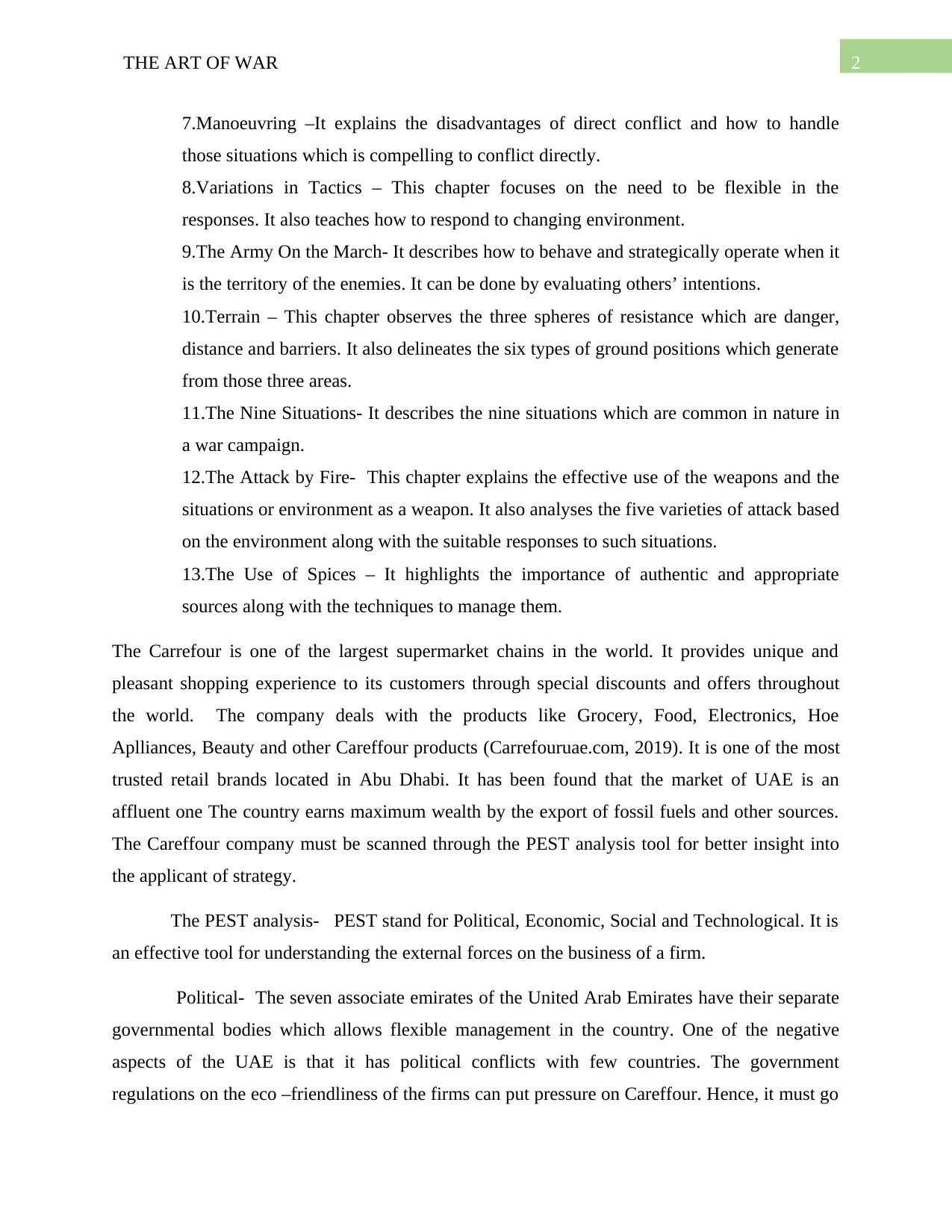
2THE ART OF WAR
7.Manoeuvring –It explains the disadvantages of direct conflict and how to handle
those situations which is compelling to conflict directly.
8.Variations in Tactics – This chapter focuses on the need to be flexible in the
responses. It also teaches how to respond to changing environment.
9.The Army On the March- It describes how to behave and strategically operate when it
is the territory of the enemies. It can be done by evaluating others’ intentions.
10.Terrain – This chapter observes the three spheres of resistance which are danger,
distance and barriers. It also delineates the six types of ground positions which generate
from those three areas.
11.The Nine Situations- It describes the nine situations which are common in nature in
a war campaign.
12.The Attack by Fire- This chapter explains the effective use of the weapons and the
situations or environment as a weapon. It also analyses the five varieties of attack based
on the environment along with the suitable responses to such situations.
13.The Use of Spices – It highlights the importance of authentic and appropriate
sources along with the techniques to manage them.
The Carrefour is one of the largest supermarket chains in the world. It provides unique and
pleasant shopping experience to its customers through special discounts and offers throughout
the world. The company deals with the products like Grocery, Food, Electronics, Hoe
Aplliances, Beauty and other Careffour products (Carrefouruae.com, 2019). It is one of the most
trusted retail brands located in Abu Dhabi. It has been found that the market of UAE is an
affluent one The country earns maximum wealth by the export of fossil fuels and other sources.
The Careffour company must be scanned through the PEST analysis tool for better insight into
the applicant of strategy.
The PEST analysis- PEST stand for Political, Economic, Social and Technological. It is
an effective tool for understanding the external forces on the business of a firm.
Political- The seven associate emirates of the United Arab Emirates have their separate
governmental bodies which allows flexible management in the country. One of the negative
aspects of the UAE is that it has political conflicts with few countries. The government
regulations on the eco –friendliness of the firms can put pressure on Careffour. Hence, it must go
7.Manoeuvring –It explains the disadvantages of direct conflict and how to handle
those situations which is compelling to conflict directly.
8.Variations in Tactics – This chapter focuses on the need to be flexible in the
responses. It also teaches how to respond to changing environment.
9.The Army On the March- It describes how to behave and strategically operate when it
is the territory of the enemies. It can be done by evaluating others’ intentions.
10.Terrain – This chapter observes the three spheres of resistance which are danger,
distance and barriers. It also delineates the six types of ground positions which generate
from those three areas.
11.The Nine Situations- It describes the nine situations which are common in nature in
a war campaign.
12.The Attack by Fire- This chapter explains the effective use of the weapons and the
situations or environment as a weapon. It also analyses the five varieties of attack based
on the environment along with the suitable responses to such situations.
13.The Use of Spices – It highlights the importance of authentic and appropriate
sources along with the techniques to manage them.
The Carrefour is one of the largest supermarket chains in the world. It provides unique and
pleasant shopping experience to its customers through special discounts and offers throughout
the world. The company deals with the products like Grocery, Food, Electronics, Hoe
Aplliances, Beauty and other Careffour products (Carrefouruae.com, 2019). It is one of the most
trusted retail brands located in Abu Dhabi. It has been found that the market of UAE is an
affluent one The country earns maximum wealth by the export of fossil fuels and other sources.
The Careffour company must be scanned through the PEST analysis tool for better insight into
the applicant of strategy.
The PEST analysis- PEST stand for Political, Economic, Social and Technological. It is
an effective tool for understanding the external forces on the business of a firm.
Political- The seven associate emirates of the United Arab Emirates have their separate
governmental bodies which allows flexible management in the country. One of the negative
aspects of the UAE is that it has political conflicts with few countries. The government
regulations on the eco –friendliness of the firms can put pressure on Careffour. Hence, it must go
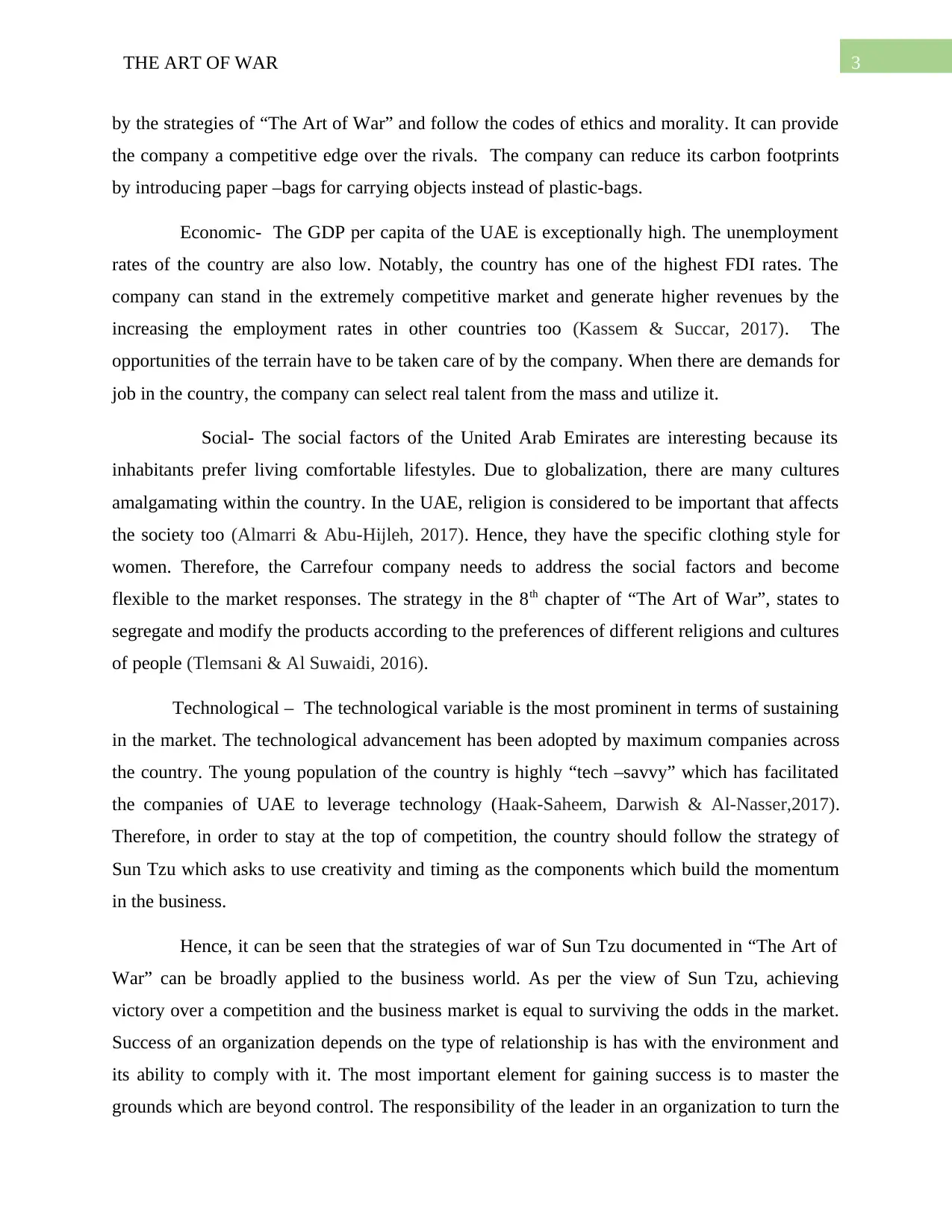
3THE ART OF WAR
by the strategies of “The Art of War” and follow the codes of ethics and morality. It can provide
the company a competitive edge over the rivals. The company can reduce its carbon footprints
by introducing paper –bags for carrying objects instead of plastic-bags.
Economic- The GDP per capita of the UAE is exceptionally high. The unemployment
rates of the country are also low. Notably, the country has one of the highest FDI rates. The
company can stand in the extremely competitive market and generate higher revenues by the
increasing the employment rates in other countries too (Kassem & Succar, 2017). The
opportunities of the terrain have to be taken care of by the company. When there are demands for
job in the country, the company can select real talent from the mass and utilize it.
Social- The social factors of the United Arab Emirates are interesting because its
inhabitants prefer living comfortable lifestyles. Due to globalization, there are many cultures
amalgamating within the country. In the UAE, religion is considered to be important that affects
the society too (Almarri & Abu-Hijleh, 2017). Hence, they have the specific clothing style for
women. Therefore, the Carrefour company needs to address the social factors and become
flexible to the market responses. The strategy in the 8th chapter of “The Art of War”, states to
segregate and modify the products according to the preferences of different religions and cultures
of people (Tlemsani & Al Suwaidi, 2016).
Technological – The technological variable is the most prominent in terms of sustaining
in the market. The technological advancement has been adopted by maximum companies across
the country. The young population of the country is highly “tech –savvy” which has facilitated
the companies of UAE to leverage technology (Haak-Saheem, Darwish & Al-Nasser,2017).
Therefore, in order to stay at the top of competition, the country should follow the strategy of
Sun Tzu which asks to use creativity and timing as the components which build the momentum
in the business.
Hence, it can be seen that the strategies of war of Sun Tzu documented in “The Art of
War” can be broadly applied to the business world. As per the view of Sun Tzu, achieving
victory over a competition and the business market is equal to surviving the odds in the market.
Success of an organization depends on the type of relationship is has with the environment and
its ability to comply with it. The most important element for gaining success is to master the
grounds which are beyond control. The responsibility of the leader in an organization to turn the
by the strategies of “The Art of War” and follow the codes of ethics and morality. It can provide
the company a competitive edge over the rivals. The company can reduce its carbon footprints
by introducing paper –bags for carrying objects instead of plastic-bags.
Economic- The GDP per capita of the UAE is exceptionally high. The unemployment
rates of the country are also low. Notably, the country has one of the highest FDI rates. The
company can stand in the extremely competitive market and generate higher revenues by the
increasing the employment rates in other countries too (Kassem & Succar, 2017). The
opportunities of the terrain have to be taken care of by the company. When there are demands for
job in the country, the company can select real talent from the mass and utilize it.
Social- The social factors of the United Arab Emirates are interesting because its
inhabitants prefer living comfortable lifestyles. Due to globalization, there are many cultures
amalgamating within the country. In the UAE, religion is considered to be important that affects
the society too (Almarri & Abu-Hijleh, 2017). Hence, they have the specific clothing style for
women. Therefore, the Carrefour company needs to address the social factors and become
flexible to the market responses. The strategy in the 8th chapter of “The Art of War”, states to
segregate and modify the products according to the preferences of different religions and cultures
of people (Tlemsani & Al Suwaidi, 2016).
Technological – The technological variable is the most prominent in terms of sustaining
in the market. The technological advancement has been adopted by maximum companies across
the country. The young population of the country is highly “tech –savvy” which has facilitated
the companies of UAE to leverage technology (Haak-Saheem, Darwish & Al-Nasser,2017).
Therefore, in order to stay at the top of competition, the country should follow the strategy of
Sun Tzu which asks to use creativity and timing as the components which build the momentum
in the business.
Hence, it can be seen that the strategies of war of Sun Tzu documented in “The Art of
War” can be broadly applied to the business world. As per the view of Sun Tzu, achieving
victory over a competition and the business market is equal to surviving the odds in the market.
Success of an organization depends on the type of relationship is has with the environment and
its ability to comply with it. The most important element for gaining success is to master the
grounds which are beyond control. The responsibility of the leader in an organization to turn the
Secure Best Marks with AI Grader
Need help grading? Try our AI Grader for instant feedback on your assignments.
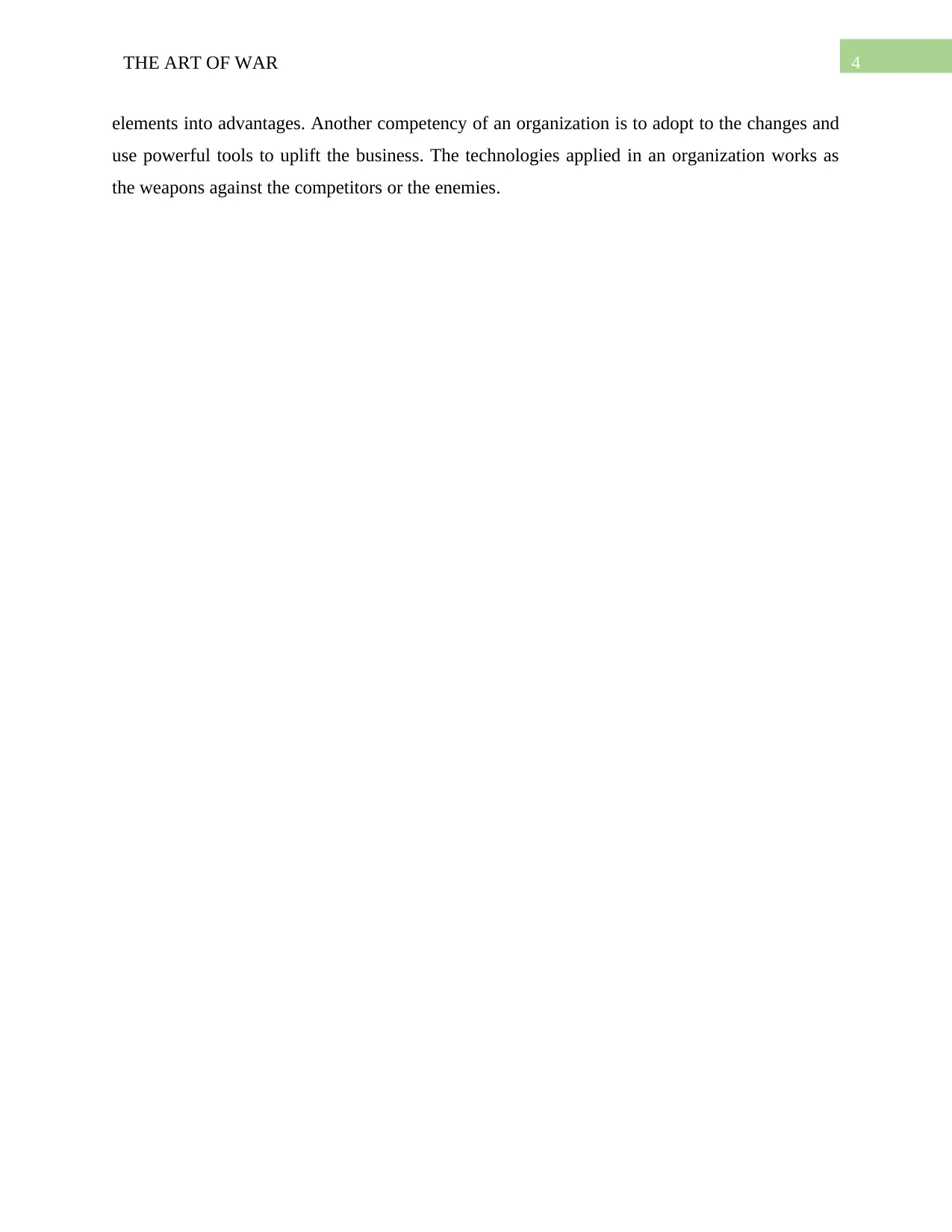
4THE ART OF WAR
elements into advantages. Another competency of an organization is to adopt to the changes and
use powerful tools to uplift the business. The technologies applied in an organization works as
the weapons against the competitors or the enemies.
elements into advantages. Another competency of an organization is to adopt to the changes and
use powerful tools to uplift the business. The technologies applied in an organization works as
the weapons against the competitors or the enemies.
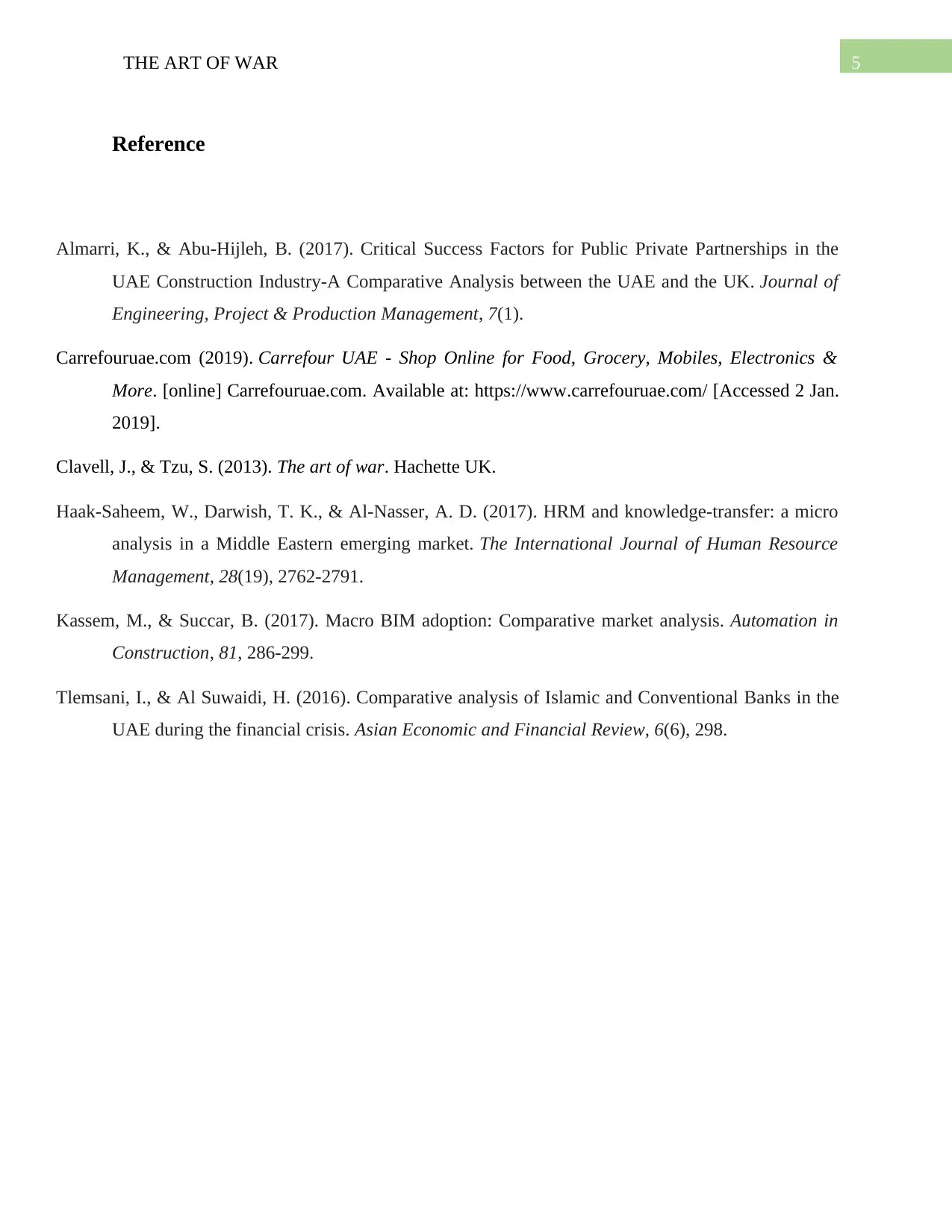
5THE ART OF WAR
Reference
Almarri, K., & Abu-Hijleh, B. (2017). Critical Success Factors for Public Private Partnerships in the
UAE Construction Industry-A Comparative Analysis between the UAE and the UK. Journal of
Engineering, Project & Production Management, 7(1).
Carrefouruae.com (2019). Carrefour UAE - Shop Online for Food, Grocery, Mobiles, Electronics &
More. [online] Carrefouruae.com. Available at: https://www.carrefouruae.com/ [Accessed 2 Jan.
2019].
Clavell, J., & Tzu, S. (2013). The art of war. Hachette UK.
Haak-Saheem, W., Darwish, T. K., & Al-Nasser, A. D. (2017). HRM and knowledge-transfer: a micro
analysis in a Middle Eastern emerging market. The International Journal of Human Resource
Management, 28(19), 2762-2791.
Kassem, M., & Succar, B. (2017). Macro BIM adoption: Comparative market analysis. Automation in
Construction, 81, 286-299.
Tlemsani, I., & Al Suwaidi, H. (2016). Comparative analysis of Islamic and Conventional Banks in the
UAE during the financial crisis. Asian Economic and Financial Review, 6(6), 298.
Reference
Almarri, K., & Abu-Hijleh, B. (2017). Critical Success Factors for Public Private Partnerships in the
UAE Construction Industry-A Comparative Analysis between the UAE and the UK. Journal of
Engineering, Project & Production Management, 7(1).
Carrefouruae.com (2019). Carrefour UAE - Shop Online for Food, Grocery, Mobiles, Electronics &
More. [online] Carrefouruae.com. Available at: https://www.carrefouruae.com/ [Accessed 2 Jan.
2019].
Clavell, J., & Tzu, S. (2013). The art of war. Hachette UK.
Haak-Saheem, W., Darwish, T. K., & Al-Nasser, A. D. (2017). HRM and knowledge-transfer: a micro
analysis in a Middle Eastern emerging market. The International Journal of Human Resource
Management, 28(19), 2762-2791.
Kassem, M., & Succar, B. (2017). Macro BIM adoption: Comparative market analysis. Automation in
Construction, 81, 286-299.
Tlemsani, I., & Al Suwaidi, H. (2016). Comparative analysis of Islamic and Conventional Banks in the
UAE during the financial crisis. Asian Economic and Financial Review, 6(6), 298.
1 out of 6
Related Documents
Your All-in-One AI-Powered Toolkit for Academic Success.
+13062052269
info@desklib.com
Available 24*7 on WhatsApp / Email
![[object Object]](/_next/static/media/star-bottom.7253800d.svg)
Unlock your academic potential
© 2024 | Zucol Services PVT LTD | All rights reserved.





